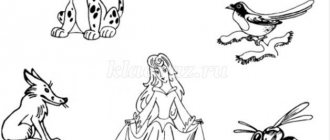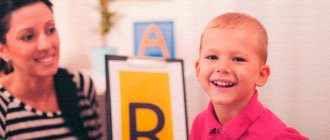Articulation of sound [C]
The sound [S] is a consonant, deaf, hard, front-lingual. Normally, by the age of four, children have formed the correct pronunciation of whistling sounds.
Articulation of sound [C] The lips are stretched in a wide smile, teeth are visible, between which there is a distance of about 2 mm. The end of the tongue rests on the lower incisors, the back of the tongue takes the “slide” position. A groove is formed in the middle of the tongue, through which a cold stream of air flows. We don't use our voice.
Effective classes with a speech therapist starting with the letter C
A qualified speech therapist will not use methods that force a child to do something he does not want to do.
How does a sound production lesson work [C]
An experienced speech therapist's appointment consists of fun games, close to pampering, when a child, together with an adult, is allowed to make faces in front of the mirror and utter various funny syllables.
Individual lessons on audio automation [C]
Such exercises should be regular until the result is achieved. Mandatory exercises for the formation of the correct sound include a game of imitating the noise of a pump, a blizzard, or a deflating balloon.
In a family where adults take the trouble to communicate with the child once a day, not in a hurry, but thoughtfully, correcting the pronunciation they hear, the child will gradually begin to speak clearly in a natural environment. Care in the family, a healthy moral environment and an adequate assessment of abilities are the key to a successful and psychologically healthy child.
Disadvantages of pronunciation of the sound [S]
- Interdental sigmatism . When pronouncing the sound [C], the end of the tongue falls between the teeth. This prevents the air stream from escaping. The blown air becomes warm. The resulting sound resembles [T].
- Nasal sigmatism . The tongue goes back, the lips are connected. The air rises to the soft palate and exits through the nose. Often, instead of [C], a similarity to [X] is heard. Here it is important to make sure that the child does not have rhinolalia or rhinophony.
- Lateral sigmatism . The tongue goes to the side. And not just to the side, but one edge of the tongue at the top, the other at the bottom. The distance between the teeth increases. Exhaled air flows from the sides. The sound produced resembles a “squelching”.
- Labial-dental sigmatism. The sound produced resembles [F]. The upper jaw comes forward. It turns out that the lower lip comes into contact with the upper teeth.
- Dental sigmatism . The sound resembles [T]. The end of the tongue simultaneously rests on the upper and lower incisors. As a result, air cannot escape freely.
- Hissing sigmatism . The end of the tongue goes deeper into the oral cavity, the back rises high, and a groove does not form in the middle of the tongue. A “hissing” appears. Reminds me of the sound [Ш] (shabaka).
In the case of parasigmatism, persistent replacements of whistling sounds occur. The softening is not [S], but [S'], also replacing with [T], [F]. Those. the sound does not resemble a certain one, due to incorrect articulation, and the child specifically replaces [C] with another sound.
Sound setting [C].
The first stage is preparatory.
Sound production begins with preparatory work, which includes: articulatory gymnastics, development of speech breathing, establishing the level of auditory perception.
The speech therapist needs to know that the child differentiates sounds. If speech breathing is poorly developed, then difficulties may arise during sound production. And, of course, the most important part of preparation is articulation gymnastics. The development of articulation of the speech apparatus is an excellent way to prepare the speech organs.
Examples of articulation exercises for whistling sounds:
1. "Smile." The lips are very stretched in a smile. The teeth are hidden.
2. "Frog" . The child smiles widely. The teeth are visible and closed. Hold the position for about ten seconds and rest. Repeat 5-7 times.
“We imitate frogs,
We pull our lips straight to our ears.”
3. “Brushing our teeth.” Smile, open your mouth slightly, and use the tip of your tongue to “brush your teeth.” We move the tongue along the inside of the lower teeth. It is important that the tongue slides closer to the gums, and not along the edges of the teeth. The jaw is fixed.
4. “Swing” . Smile, mouth slightly open, tongue alternately rises and falls, the tip of the tongue rests on the incisors (upper and lower, respectively).
“The children sat on the swing and flew higher than the spruce tree. On the swing up and down, don’t be lazy about swinging.”
5. “Punish your tongue.” We open our mouth slightly, place the tongue on the lower lip (we try to relax the tongue, remove tension). We begin to spank it with our lips, saying “five-five…..”. You need to hold your tongue relaxed for about 10 seconds. “Clapping” occurs with one exhalation.
6. "Slide". We open our mouth. The tip of the tongue rests on the lower incisors. The back of the tongue is raised up.
7. “The ball is in the goal.” We stretch out our lips with a straw and blow on a “ball” made of cotton wool into an improvised goal. The peculiarity of this exercise: the ball must hit the goal with one exhalation. Also make sure that children do not puff out their cheeks.
Techniques for developing speech breathing can be found in the article “Development of speech breathing in preschool children.”
The time allotted for articulation gymnastics is on average 5 minutes per lesson. It is better to do it several times during the day. You shouldn’t immediately introduce your child to all kinds of exercises. Choose 3 tasks and practice them. Working on the articulation of the speech apparatus is working on the muscles and it requires effort from the baby. Do not forget that all exercises must be performed in front of a mirror so that the child can see whether he is doing the exercise correctly.
The second stage is the actual production of the sound [C].
There are three methods of sound production: by imitation, production from reference sounds, production with mechanical assistance (probes, cotton swabs, spatulas). Often there is a mixed method.
The imitation technique is suitable if there are minor defects in sound pronunciation or the sound [C] is absent. A mirror is required during the lesson, as the child must see your articulation and his own.
- Invite your child to smile widely so that his teeth are visible.
- We tense the tip of the tongue and rest it on the lower incisors.
- Ask your child to blow (on a balloon, into a bottle, on a feather) and you will hear the sound [C]. For preschool children, it is important to have a playful moment.
Labial-dental sigmatism - try to pronounce [S] with lips parted and teeth exposed. The lower lip should not “go” up. You can hold it with your hand. The exhaled speech stream should not go into the cheeks. We practice interlabial blowing (into a bottle, onto a candle). Invite your child to smile and blow - this results in interdental blowing. The next step is to hide the tongue behind the lower incisors.
Interdental and subdental sigmatism. Mechanical action is required. Press the tip of the tongue with a cotton swab and hide it behind the lower incisors. Hold your tongue and ask your child to blow and then say [C]. First separately, and then in a syllable. In the case of hissing sigmatism, interdental blowing is used, “snorting” into the tongue. Then we practice interdental pronunciation [C] of syllables, words and phrases. The tongue should fix the required position. After this, we move its tip behind the lower incisors.
With lateral sigmatism: interlabial blowing, interdental blowing, interdental pronunciation [C] in syllables, words, sentences. Then, using mechanical action, we move the tongue behind the teeth.
Nasal sigmatism. Here you need to develop an air stream in the center of the tongue (blowing on a candle, cotton wool). We start by practicing interlabial blowing, then interdental blowing and pronunciation of [C] in syllables, words, phrases. We move the tip of the tongue to the tooth position.
Setting the sound [C] - “whistle” technique.
There is a technique for setting [C], which is suitable for all types of sigmatism.
Let's call it "whistle". The mechanical effect on the tongue is exerted by the child himself with the help of his finger. What is the essence of this method? The preschooler places his index finger (about 2 centimeters) on his wide tongue, which lies behind his lower teeth. He bites his finger with his upper teeth. Conventionally, he has a “whistle” in his mouth. At the same time, the lips are stretched in a wide smile, in which the teeth are clearly visible. The speech therapist offers to blow on the child. The organs of articulation must remain fixed. With this method, it is better to fix [C] in reverse syllables.
The third stage is consolidation and automation.
Establishing the correct pronunciation of an isolated sound is only the beginning of the journey. Now it is important to automate it. Automation is happening gradually.
Examples of tasks and exercises for automation:
• Syllables for repetition reflected SA - SA - SY SA - SY - SA SY - SA - SY
AS - OS - US US - YS - AS
SVA SMO SPA (choose those sounds that the child pronounces correctly) SVO SMU SPU
• Learning pure sayings. Sa - sa - sa - the wasp is flying. Su - su - su - did you see the wasp? Sy - sy - sy - no wasp. (the child can pronounce the syllables, and the speech therapist can continue the sentence. Then you can switch places).
• “Choose and name.” The preschooler has pictures in front of him. His task is to select and name those that depict food products. (juice, sugar, sofa, cheese, soup, chair).
• Words to repeat reflectively. Juice, Sonya, owl, sock, piece, falcon, forest, voice, wheel, sun, beans.
• “One is many” An adult says the word in the singular, children in the plural). Juice - juices dog - dogs pump - pumps
• “Finish the sentence.” The adult begins the sentence, and the child finishes by finding the corresponding picture.
An owl sits on a branch. (Pine) grows in the forest. Sonya drinks (juice).
• “Call me kindly.” (dog - doggie, owl - owl).
• Working with a plot picture. Select the picture based on the sound you are working on. And ask relevant questions.
How to teach a child to say the letter K
Parents often ask a speech therapist how to teach their child to pronounce the letter k. There is only one answer - the most effective method is constant pronunciation.
The simplest task is to regularly pronounce words with the letter “k”: cabbage, strawberry, potato, card, book, dill, spark.
At the same time, it is important to focus the child’s attention on this letter and pronounce it clearly and slowly. Children most often achieve the main progress in pronunciation in classes at preschool educational institutions.
Speech therapy lesson on differentiation of sounds [g] and [k]
How to teach a child to say the letter k if he refuses to do speech therapy? Home training often does not bring the expected result, but in kindergarten the speech therapist uses a playful approach and engages the child in play. A ready-made outline is used for the lesson.
Lesson progress on differentiating “g” and “k”:
- The teacher asks the child to guess riddles, the answers to which contain the sounds being practiced. Then he announces the topic of the lesson and the purpose.
- Kids are asked the question: “What is the difference between “g” and “k”? Children should say that they have different sounds, teeth and tongue positions when pronouncing. The speech therapist invites children to pronounce words with their hand on their throat. The sound is very different.
- Work is underway with notebooks. The guys write down the syllables: gu-ku, gi-ki, go-ko, ga-ka and pronounce them. A fast pace and its alternation with a slow one is important.
- At the end of the lesson, the children pronounce pure sayings: “ha-ha-ha - the geese came out into the meadows.”
Frontal speech therapy lesson in the preparatory group
After the main block of the lesson, children do a warm-up and then do an exercise in which they need to insert the missing letters in a word.
Important! During the lesson, the speech therapist pays attention to the children for whom pronunciation is most difficult, and then conducts individual work with them.





